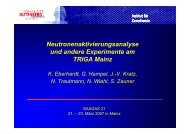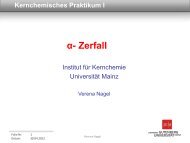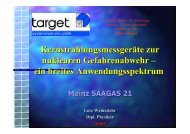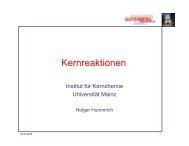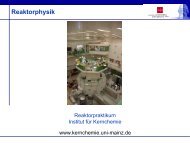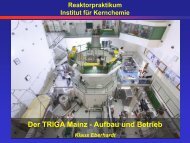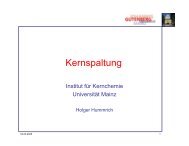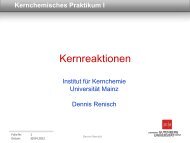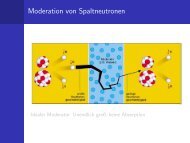jahresbericht 2007 - Institut für Kernchemie - Johannes Gutenberg ...
jahresbericht 2007 - Institut für Kernchemie - Johannes Gutenberg ...
jahresbericht 2007 - Institut für Kernchemie - Johannes Gutenberg ...
Create successful ePaper yourself
Turn your PDF publications into a flip-book with our unique Google optimized e-Paper software.
Mass measurements and collinear laser spectroscopy on neutron-rich and<br />
heavy nuclides at the research reactor TRIGA Mainz ∗<br />
J. Krämer 1 , K. Blaum 1,2,3 , M. Block 2 , K. Eberhardt 1 , G. Eitel 1 , R. Ferrer 1 , Ch. Geppert 1 , S. George 1 ,<br />
F. Herfurth 2 , J. Ketelaer 1 , J. Ketter 1 , H.-J. Kluge 2 , Sz. Nagy 1 , D. Neidherr 1 , R. Neugart 1 , W.<br />
Nörtershäuser 1,2 , J. Repp 1 , C. Smorra 1 , N. Trautmann 1 , and C. Weber 4<br />
1 University Mainz, Germany; 2 GSI, Darmstadt, Germany; 3 Max-Planck-<strong>Institut</strong> für Kernphysik, Heidelberg, Germany;<br />
4 University of Jyväskylä, Finland<br />
The TRIGA-SPEC project comprises a Penning trap<br />
setup for high-precision mass measurements as well as a<br />
beamline for collinear laser spectroscopy on neutron-rich<br />
and heavy nuclides at the research reactor TRIGA Mainz.<br />
These techniques have been employed for decades at online<br />
facilities, but to reach regions further away from stability<br />
and to improve accuracy, e.g., for fundamental tests<br />
of the standard model, a continous effort towards the development<br />
of more efficient and more accurate techniques is<br />
required. TRIGA-SPEC is devoted as a test bench particularly<br />
for the planned MATS [1] and LASPEC [2] facility at<br />
FAIR.However, due to the infrastructure at Mainz and the<br />
coupling to the research reactor, it provides also the opportunity<br />
to perform measurements on heavy trans-actinides as<br />
well as short-lived fission products far away from the valley<br />
of stability. The data provided will be of high interest for<br />
nuclear structure studies. The proposed experimental setup<br />
is shown in Fig. 1. Thermal neutron induced fission nuclei<br />
will be produced in a target chamber placed near the reactor<br />
core and transported towards an ion source via a gas-jet<br />
transport system [3].<br />
For first off-line measurements on heavy actinide el-<br />
148<br />
∗ Work supported by HGF under contracts VH-NG-037 and VH-NG-<br />
ements between 235 U and 249 Cf, a laser desorption ion<br />
source has been developed. Ions of heavy elements as well<br />
as carbon clusters for mass calibration are produced with a<br />
pulsed frequency-doubled Nd:YAG laser with a wavelength<br />
of 532 nm and a pulse length of 3-5 ns. The ion-optical<br />
transport from the source to the Penning traps was optimized<br />
using SIMION 8.0 simulations and the transport efficiency<br />
for shooting ions through the traps is estimated to be<br />
80%. For the cylindrical purification trap and the hyperbolical<br />
precision trap [4], a 7 T superconducting magnet similar<br />
to the one at SHIPTRAP [5] was installed and commissioned.<br />
For the very first time the Fourier-Transform Ion<br />
Cyclotron Resonance (FTICR) detection method, which<br />
was improved to reach single ion sensitivity, will be applied<br />
for mass measurements on heavy nuclei. For mass<br />
separation of the fission products a 90 ◦ dipole mass separator<br />
will be used, which reaches a mass energy product<br />
of 15 MeVamu. To guide the ions either to the Penning<br />
trap or to the collinear laser spectroscopy beamline a 45 ◦<br />
electrostatic switchyard was designed and optimized with<br />
SIMION 8.0 simulations. For the collinear beamline an<br />
alkaline vapour charge exchange cell and an ion deflector<br />
with optical viewports to overlap the ion or atom beam with<br />
the laser were designed and are currently being manufactured.<br />
Collinear spectroscopy needs an accurate determination<br />
of the acceleration voltage [6]. Thus, we are going<br />
to test a high precision voltage divider with an accuracy of<br />
10 −5 for voltages up to 60 kV. Additionally, the applicability<br />
of a frequency comb for absolute measurements of the<br />
transition frequencies will be investigated.<br />
References<br />
Figure 1: Experimental setup with the mass spectrometry<br />
beamline to the left and the laser spectroscopy beamline to<br />
the right. Fission products will be transported by a carrier<br />
gas to the ion source and subsequently mass separated.<br />
[1] K. Blaum, Phys. Rep. 425 (2006) 1<br />
[2] W. Nörtershäuser, P. Campbell, and the LASPEC collaboration,<br />
Hyp. Int. 171 (2006) 149.<br />
[3] E. Stender, N. Trautmann, G. Herrmann, Radiochem. Radioanal.<br />
Lett. 42 (1980) 291.<br />
[4] C. Weber, K. Blaum, M. Block, R. Ferrer, F. Herfurth, H.-J.<br />
Kluge, C. Kozhuharov, G. Marx, M. Mukherjee, W. Quint, S.<br />
Rahaman, S. Stahl, the SHIPTRAP collaboration, Eur. Phys.<br />
J. A 25 S01 (2005) 25.<br />
[5] S. Rahaman, M. Block, D. Ackermann, D. Beck, A. Chaudhuri,<br />
S. Eliseev, H. Geissel, D. Habs, F. Herfurth, F.P.<br />
Heberger, et al., Int. J. Mass Spectrom. 251 (2006) 146.<br />
[6] S. L. Kaufmann, Opt. Comm. 17 (1976) 309.<br />
- A1 -



